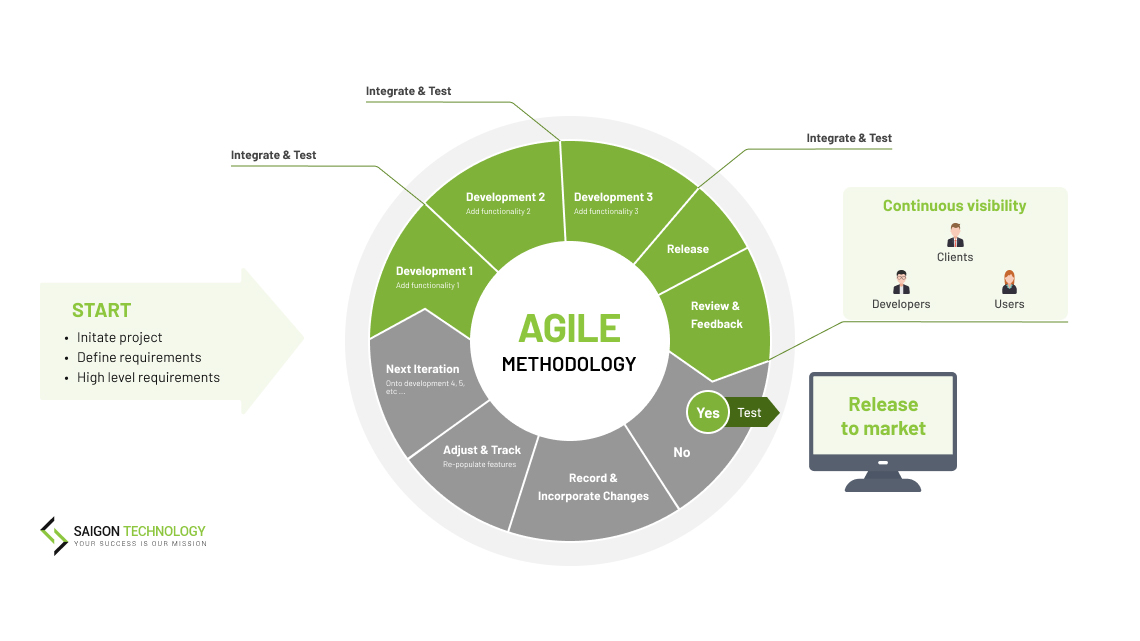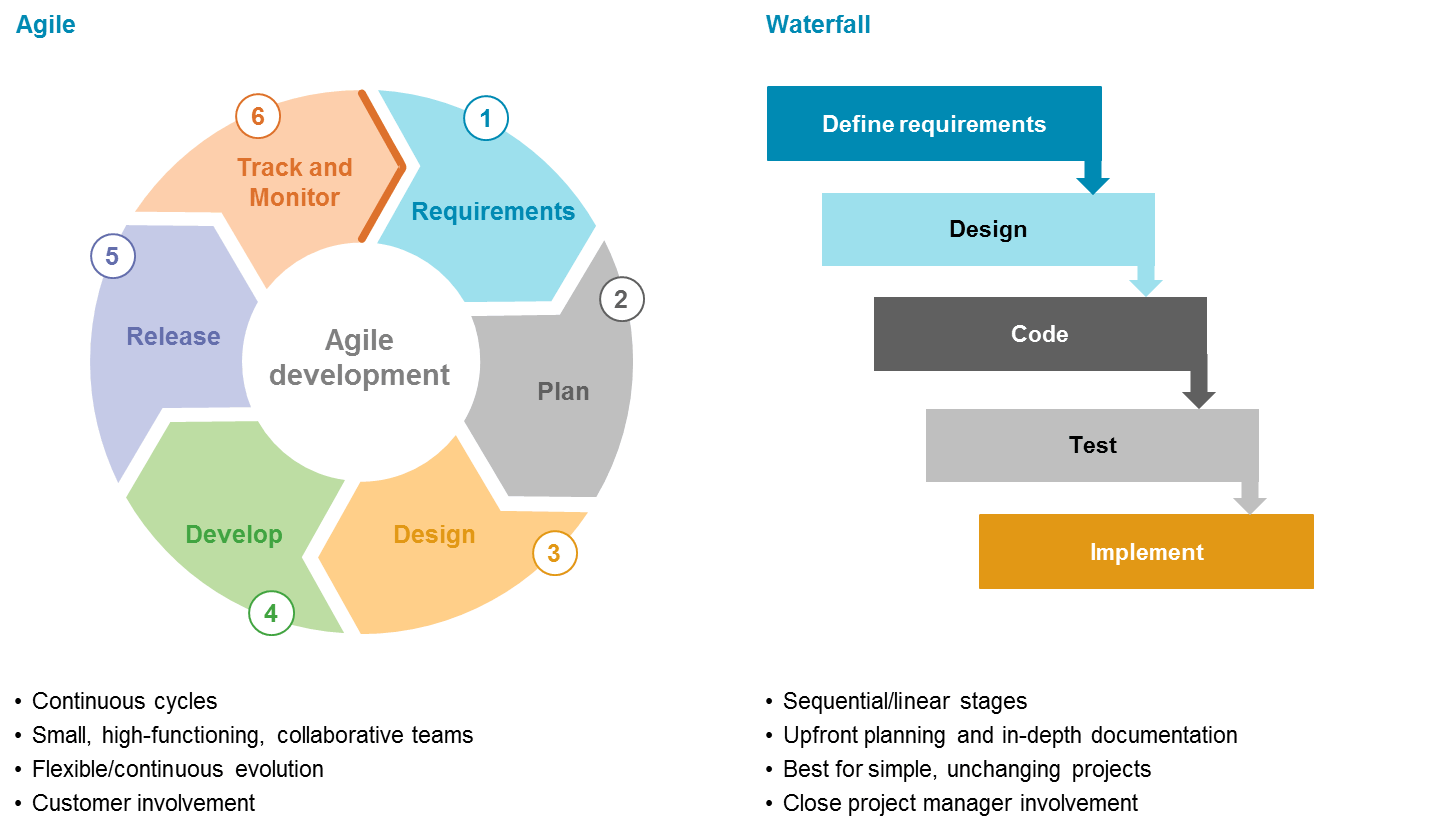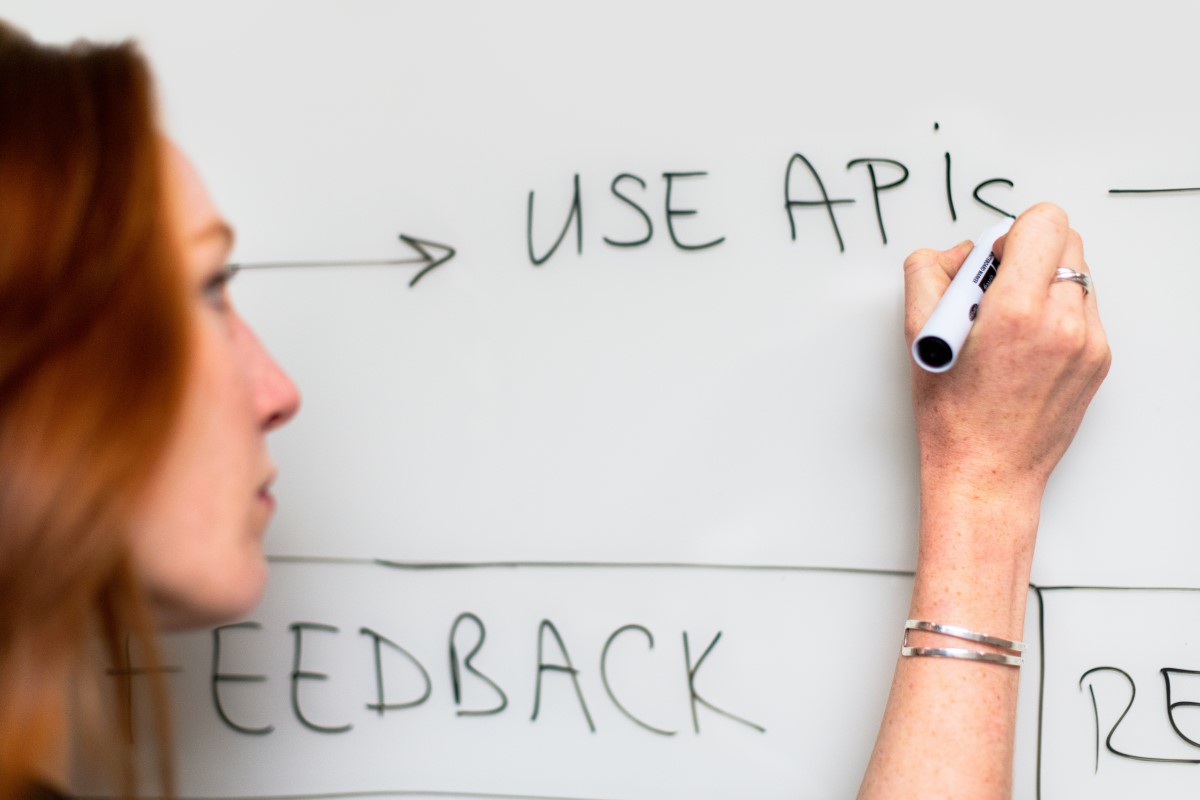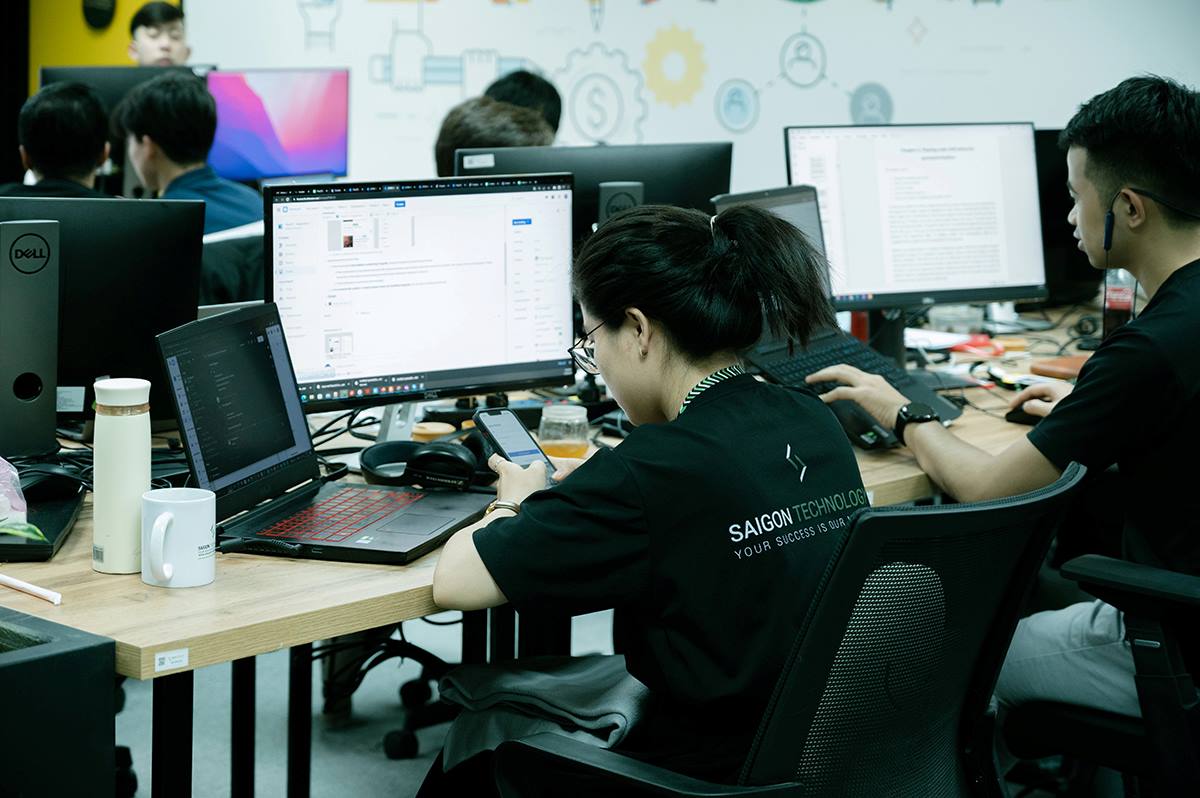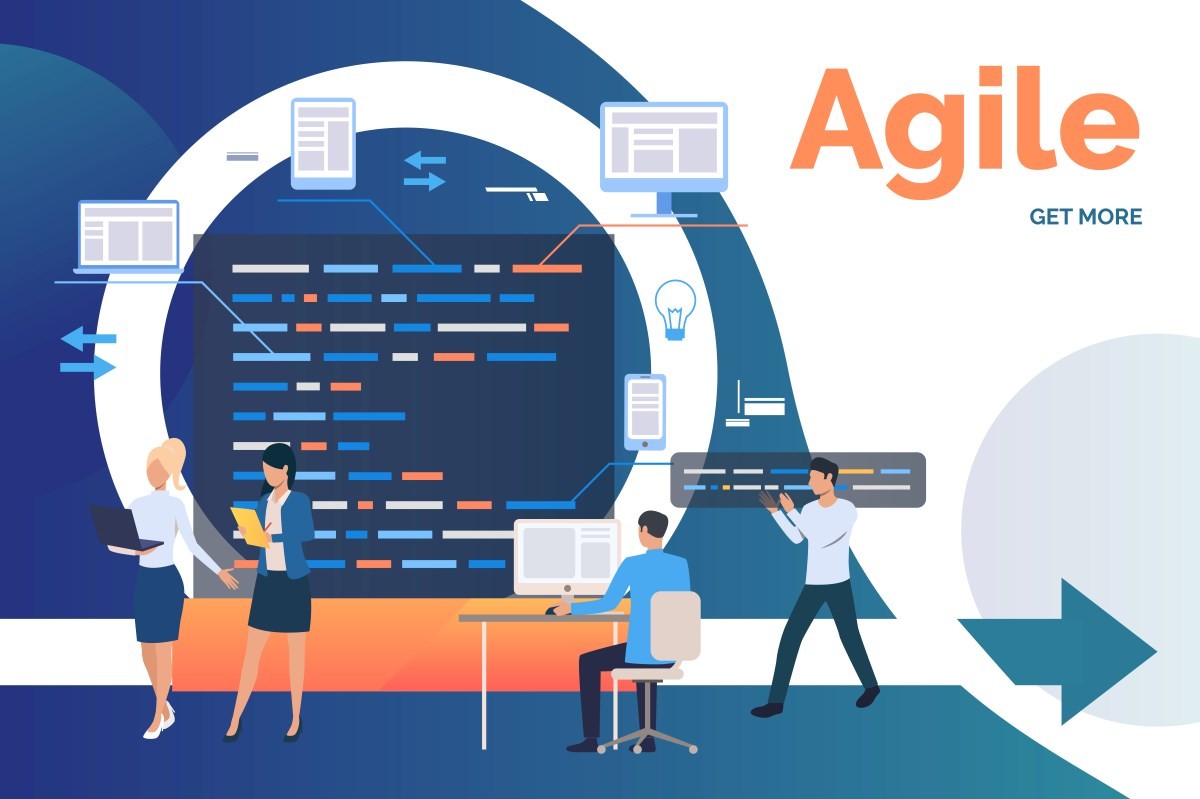In today’s fast-moving business world, companies need to stay flexible and responsive to stay ahead. Agile methodology is a widely used approach in software development and project management. It helps teams work more efficiently, improve collaboration, and stay focused on customer needs.
The term “Agile” signifies a mindset that values flexibility in development and encourages continuous delivery of high-quality outcomes.
This article explores Agile methodology, its key principles, main frameworks, and real-world benefits. This method helps teams tackle common challenges and follow best practices for a seamless and successful implementation.
Adapting to Uncertainty
Navigating uncertainty requires a method that embraces adaptive planning and responsive workflows. Agile development helps teams manage unpredictability. It breaks projects into smaller, manageable parts. It allows them to improve constantly through iterative development. The 15th State of Agile Report shows that 64% of organizations use Agile to handle changing priorities better.
Traditional frameworks like Waterfall can be rigid. In contrast, Agile planning cycles are more flexible in executing projects. And yes, risks and pivot strategies need to be addressed as necessary. It’s the essence of adaptive project management and uncertainty management.
Agile in Project Management
Agile project management (APM) extends beyond software, proving effective for all teams. The core of Agile software development lies in its iterative project management practice. It’s focused on facilitating cross-functional collaboration and promoting self-organizing teams. These teams can deliver value consistently and adapt to changes swiftly.
Popular methodologies like Scrum vs. Kanban highlight different ways to implement Agile delivery and achieve continuous improvement. They emphasize adaptability, predictability in Agile software development, and a commitment to high-quality outcomes.
Key Agile Methodologies
Two prominent Agile methodologies are the Scrum framework and Kanban methodology. Scrum Sprints typically last two to four weeks and are structured into short, time-boxed iterations. Each Sprint review allows teams to reflect on and refine their processes.
Kanban’s continuous flow system focuses on work visualization and managing work-in-progress (WIP) limits. This methodology is ideal for those needing flexibility to handle unpredictable workloads. It promotes a lean process and fosters a process reflection and improvement culture.
By understanding and applying these principles, teams can enhance their Agile mindset. In doing so, they can ensure they remain resilient and adaptable in any project landscape.
What is the Agile Development?
Agile methodology is a flexible approach to project management and software development. It emphasizes continuous delivery, teamwork with customers, and adapting to changes. The traditional Waterfall method follows a strict step-by-step process with little room for change. In contrast, Agile allows for continuous planning, gradual improvements, and frequent progress reviews.
Agile as a Project Management Approach
At its core, it encourages flexible and responsive agile workflows. Teams work in incremental delivery cycles, ensuring high-quality software product delivery.
In Scrum, a team of developers, testers, and designers work together during a sprint. The Agile product owner ensures alignment with business priorities. This structure fosters continuous collaboration and rapid adaptation. Agile methods fit well with DevOps by focusing on teamwork, automation, and ongoing improvement. This combination helps deliver value to end-users faster.
Here’s the bigger picture when it comes to Agile vs. Waterfall project management approaches:
Agile
- Approach: Iterative, with frequent feedback loops
- Focus: Continuous releases and customer feedback
- Benefits: Quicker feedback, faster product releases, and better customer satisfaction
- Best for: Digital projects with evolving requirements
Waterfall
- Approach: Linear, sequential, and phase-by-phase
- Focus: Thorough planning and execution in predetermined stages
- Best for: Large infrastructure projects like construction, manufacturing, bridges, and tunnels
Team Collaboration and Self-Organization
A hallmark of Agile principles is emphasizing self-organizing teams and team empowerment. Autonomy in Agile guarantees teams make decisions collaboratively and efficiently.
Cross-functional collaboration brings together experts from different areas to create one product. Trust and communication are key, allowing them to focus on product prioritization and delivering value.
Flexibility in Agile Frameworks and Practices
The Agile Alliance supports different methods. These methods are flexible and suited to various tasks. You can choose Scrum, Kanban, or a hybrid Agile approach. These frameworks emphasize feedback and constant improvement during the software development life cycle.
Teams use methods like Scrum-Kanban to improve workflows and stay flexible. Following the Agile Manifesto Principles encourages adaptability and responsiveness to change.
Practices and Frameworks in Agile
Adequate Agile development relies on practices such as pair programming, test-driven development (TDD), and continuous integration (CI).
Daily stand-ups, code reviews, and other Agile practices help maintain momentum and quality. Tools like Kanban boards and Scrum ceremonies keep teams aligned and focused on their objectives.
People-Centered Focus
A central tenet of Agile methodology is its human-centric Agile method. This approach aims to foster a team collaboration culture and knowledge-sharing systems. These environments promote learning in Agile. They encourage problem-solving frameworks that improve team synergy. Management support in Agile is crucial, as it provides guidance and enables Agile knowledge transfer.
The Role of Managers in Agile
In an Agile setting, supportive management focuses on Agile leadership and team skill-building. Agile coaching helps teams tackle challenges. It also promotes a management style that supports independence. This leadership in Agile environments provides effective conflict resolution and resource allocation.
Technical Practices in Agile
Technical excellence is a cornerstone of Agile methodology. Practices like automated testing, continuous delivery, and CI/CD pipelines can bear high standards. Quality assurance in Agile involves rigorous software integration practices and risk management. Refactoring best practices can deliver reliable and efficient solutions in Agile technical workflows.
Iterative Nature of Agile
Its emphasis on Agile retrospectives, sprint cycles, and feedback-driven development is evident. Teams check their performance with sprint planning, reviews, bottleneck analysis, and workflow improvements. This process fosters continuous adaptation and iterative design and delivery.
Agile Development Philosophy
At its core, Agile’s philosophy values customer-focused development and market-aligned solutions. Agile leadership principles highlight team accountability and a commitment to rapid software delivery. Teams can achieve their Agile vision and goals by keeping a continuous feedback cycle. This can lead to them becoming high-performing Agile teams.
Agile Beyond Software
While rooted in software, Agile principles extend to various industries. You can use Agile in different ways. Examples include Agile for hardware, iterative design, and Agile prototyping. These include Agile in product development and Agile manufacturing processes. It supports cross-industry Agile applications and fosters multi-disciplinary Agile teams.
Top 10 Agile Methodologies
1. Scrum
A structured Agile framework that organizes work into time-boxed Sprints (typically 2-4 weeks). This framework provides a systematic yet flexible method for team-level project management. Teams operate with defined roles: Scrum Master, Product Owner, and Development Team. Focuses on regular stand-up meetings, sprint planning, and retrospective analysis. It divides tasks into smaller, more manageable components, prioritizing and addressing flexibly. The 14th Annual State of Agile Report by VersionOne found that 58% of organizations boost productivity and efficiency with Agile, especially Scrum.
The key roles within the Scrum method:
- Product Owner: It acts as the customer’s voice and has the final say on the product’s outcome.
- Scrum Master: This role guides the team. It organizes daily meetings, improves group dynamics, and boosts productivity.
To keep the process organized:
- Product Backlog: The product owner manages the list. It includes all project tasks, features, and requirements.
- Sprint Backlog: A more immersed list from the product backlog containing tasks selected for the upcoming sprint.
- Product Increment: This represents the cumulative result of all tasks completed during a sprint.
Activities for smooth project progression:
- Sprint: This is a fixed period, usually two to four weeks. During this time, the team works on tasks from the sprint backlog.
- Daily Stand-up: A brief meeting during which members share updates on their progress, discuss challenges, and plan their day.
- Sprint Review: At the end of each sprint, they present their completed work to stakeholders.
- Sprint Retrospective: After the sprint review, they meet. They discuss the workflow and processes.
Common Challenges:
Scrum’s defined roles and strict time-boxing can challenge teams with varying experience levels. For those new to Scrum, understanding and embracing specific roles such as product owner and Scrum master may take time.
Real-world Example:
Imagine a software development company using Scrum to build a mobile app. With each sprint, the team delivers new features in small, manageable increments. After each sprint, they gather user feedback, which helps them adjust their priorities.
2. Kanban Framework
It’s a simple yet powerful Agile framework that helps teams visualize their workflow. A visual workflow management system designed to optimize efficiency. Studies show that organizations using Kanban see workflow efficiency improvements of 30% to 40%. Here are some fundamental concepts of Kanban:
- Work In Progress (WIP): Limiting the number of tasks being worked on at any given time to avoid overloading.
- Kanban Board: A visual tool for organizing tasks into columns. These include “To Do,” “In Progress,” and “Done” to track the status of each task.
- Flow: Managing the movement of tasks through different process stages.
- Bottleneck: A point in the workflow where tasks get delayed or stalled, slowing overall advancement.
- Pull System: Teams only pull new tasks when they can work on them, avoiding overcommitment.
- Cycle Time: The total time it takes for a task to move from the “To Do” column to “Done.” This helps them measure and improve efficiency.
Ideal for continuous delivery with no fixed iterations.
Common Challenges:
Scaling Kanban can be complex without a structured framework. It becomes particularly challenging when several teams are involved.
Real-world Example:
A customer support team might use Kanban to manage support tickets. Visualizing tasks on a Kanban board can ensure no one is overwhelmed by too many tickets. The team can prioritize high-priority issues and address them first.
3. Extreme Programming (XP)
Extreme Programming (XP) is a software development framework that prioritizes high-quality coding practices. As an Agile methodology, it breaks work into short cycles called iterations. This approach helps teams adjust to changing user needs, even in the later stages of development, while maintaining high product quality.
The 14th Annual State of Agile Report by VersionOne found that 54% of organizations using XP report better product quality.
What makes XP stand out is its focus on technical excellence.
- Test-Driven Development (TDD): Writing tests before coding ensures high-quality, reliable software from the beginning.
- Pair Programming: Two developers work together on the same task, sharing ideas and improving code quality.
- Continuous Integration (CI): Code changes are frequently integrated into the main codebase. It reduces integration issues and keeps the code up-to-date.
- Refactoring: Improving the quality of the code without changing its functionality. This makes it cleaner and easier to maintain.
- Frequent Releases: Deploying small software updates helps the product improve. It also uses feedback.
- Customer Collaboration: Developers work with customers. They ensure the product meets their needs and expectations.
Common Challenges:
Extreme Programming (XP) requires a strong commitment to discipline and teamwork. This can be challenging to achieve, especially in larger groups or environments with less experienced members.
Real-world Example:
A startup might choose XP to help them move fast while focusing on code quality. By adopting Test-Driven Development, the team ensures testing each part of the code before it’s written. This proactive strategy results in fewer bugs and more dependable software.
4. Lean Software Development
Lean Software Development, inspired by Toyota’s Lean Manufacturing Principles, aims to reduce waste and enhance efficiency. This approach encourages fast decision-making, minimal documentation, and ongoing refinement.
A study by the Lean Enterprise Institute found that companies using lean flow principles reduced defect rates by 50%.
The core practices of this Agile Software Development include:
- Waste Reduction: This means finding tasks that don’t improve the product. Then, remove them.
- Continuous Improvement: Lean encourages an ongoing effort to enhance operations. Teams regularly reflect on their work and seek improvement.
- Flow Efficiency: By optimizing the flow of tasks, they can deliver products with fewer bottlenecks.
- Value Stream Mapping: By mapping out all the steps in delivering a product, from concept to completion.
- Kaizen: A key philosophy in Lean, Kaizen is about fostering a culture of continuous, incremental improvement.
- Kanban provides a visual system for tracking work items as they progress. It helps them see their progress, identify bottlenecks, and manage their workload.
Common Challenges:
Implementing Lean Software Development can be demanding, mainly when resistance to change exists. Teams may struggle if they’re not fully committed to continuous improvement. Without dedication to the Lean principles, achieving the desired results becomes demanding.
Real-world Example:
A manufacturing software company could apply Lean principles to enhance its update process. The company would focus on what matters to its customers by eliminating unnecessary features. It would help streamline updates, making the software more efficient and user-friendly.
5. Feature-driven Development (FDD)
FDD is an Agile framework that breaks projects into small, testable parts. It focuses on developing software features in short cycles with constant integration.
Fundamental elements of FDD include:
- Feature List: A detailed list of all developing features.
- Feature Teams: Cross-functional teams working on specific features.
- Incremental Delivery: Delivering features in short, manageable iterations.
- Client Collaboration: Aligning features closely with client needs.
- Design and Build: Emphasis on efficient, parallel development of features.
Common Challenges:
It can face challenges in projects where priorities shift often. Since FDD relies on a structured feature list, frequent changes can disrupt the workflow. In the long run, staying on track can make it more problematic.
Real-World Example:
A large company might use FDD to create a complex software suite. Focusing on specific features helps control the Agile process. It also creates a clear, cohesive product.
6. Dynamic Systems Development Method (DSDM)
DSDM highlights iterative development and rapid prototyping. It aims to work closely with users to understand their needs. It then gathers early feedback and develops the most critical features first.
Essential Phases of DSDM:
- Time-boxing: Setting fixed deadlines for each development phase.
- MoSCoW Prioritization: Categorizing tasks into Must have, Should have, Could have, and Won’t have.
- Iterative Development: Using repeated cycles of development and feedback.
- Active User Involvement: Engaging users continuously for input throughout the process.
- Quality Assurance: Prioritizing quality from the start.
Common Challenges:
DSDM’s structured approach can limit flexibility in situations where teams need more freedom. Its strict rules may not work well. They’re not good for projects that need frequent, independent decisions.
Real-World Example
A government IT project could benefit from using DSDM. This framework ensures regular user input for fast adjustments when requirements change. Involving users throughout the process keeps the project on track. It helps meet changing needs while maintaining control and quality.
7. Crystal
This Agile methodology puts people at the center of the process. The goal is to ensure their collaboration drives the project forward, not rigid rules or pre-set methods.
Key Focus:
- People-Centric: The emphasis is on the team members and their collaboration.
- Adaptability: Processes are adjusted based on the project size and team needs.
- Clear Communication: Efficient communication is a top priority.
- Flexibility: The framework adapts to fit the specific project requirements.
- High Collaboration: Strong teamwork is encouraged to achieve the best results.
Common Challenges:
Crystal’s flexibility can be an advantage and disadvantage. Teams often face the challenge of choosing the best process tailored to their needs. It can be a tricky decision, but it’s essential for success.
Real-world Example:
A small team developing a mobile app may choose Crystal Clear to keep their collaboration strong and flexible. The approach helps them adapt their processes. It ensures the project runs without rigid routines.
8. Agile Unified Process (AUP)
AUP is an Agile adaptation of the Rational Unified Process (RUP) designed to combine the best of both worlds. This Agile methodology delivers clear guidelines yet remains adaptable to each project’s requirements.
Key Focus:
- Continuous Integration: AUP focuses on adding code early. This helps spot problems and keeps progress on track.
- Rational Unified Process (RUP): The structured RUP framework can adapt to different workflows.
- Architecture Focus: It upholds high architectural standards, even as teams adopt Agile methods.
- Best Practices: Development is guided by proven best practices for quality and efficiency.
- Iterative Development: They divide projects into smaller cycles. This helps track progress and adjust to changes.
Common Challenges:
It can be a more complex Agile framework than others. This is because a strong understanding of RUP practices might be required to implement it effectively.
Real-world Example:
A large enterprise might adopt AUP to balance strict architectural standards with flexibility. Agile iterations help the organization adapt to changing business needs. At the same time, the software remains reliable.
9. Disciplined Agile Delivery (DAD)
The DAD framework offers a hybrid approach tailored to the needs of complex organizations. Blending Scrum, Extreme Programming (XP), and Agile Modeling elements.
Fundamental Features:
- Hybrid Framework: DAD combines different Agile methods. It creates a flexible and complete approach.
- Agile Modeling: It uses modeling techniques in workflows. This helps ensure development is flexible and organized.
- Enterprise Scaling: It helps large, complex companies scale Agile practices. It also solves their challenges.
- Process Decision Framework: It helps teams choose the best methods. These methods suit their organization’s needs.
- Cross-Disciplinary Collaboration: It encourages teamwork and collaboration across different roles and teams.
Common Challenges:
The hybrid nature of DAD can be challenging. This is especially true for organizations that aren’t familiar with many frameworks. If not managed, combining different frameworks can cause confusion or inconsistency.
Real-World Example:
A global tech corporation might benefit from DAD by unifying methods across multiple departments. This process allows the organization to remain flexible while providing coordination between teams.
10. Agile Modeling
An Agile framework that uses modeling as a communication tool between developers, customers, and stakeholders. It’s all done while keeping documentation to a minimum.
Exciting features of Agile Modeling:
- Minimal Documentation: It emphasizes creating enough documentation to meet the project’s needs.
- Modeling Diagrams: Visual diagrams explain design concepts. They make it easier to understand the system’s structure and flow.
- Iterative Modeling: Models evolve as the project progresses. It provides continuous improvement and adaptation based on feedback and new insights.
- Stakeholder Involvement: Stakeholders are actively involved in the modeling process.
- Just-in-Time Modeling: This involves creating models on demand instead of preparing them beforehand.
Common Challenges:
One of the main challenges with Agile Modeling is determining the appropriate amount of documentation. Teams often find it problematic to strike the right balance, resulting in inconsistent practices.
Real-World Example:
A startup team developing a web app might adopt Agile Modeling to streamline its documentation process. By focusing on essential documentation and using visual diagrams to convey design ideas.
Fundamental Core Principles of Agile Methodology
1. Customer Satisfaction through Early and Continuous Delivery
In the world of Agile methodology, customer satisfaction is a top priority. The core principle is to deliver valuable software early and continuously. But it’s more than frequent releases; it’s about gathering and incorporating feedback regularly. This continuous feedback loop is what sets Agile apart from traditional methods.
A great example of this is Netflix. The streaming giant has mastered the art of incremental delivery with its content development. Netflix fine-tunes its offerings in real time by testing minor content updates and gauging user reactions.
In Agile development, Continuous Integration/Continuous Delivery (CI/CD) and Iterative Development allow for rapid prototyping. Teams start with a Minimum Viable Product (MVP) and keep improving based on customer feedback. This cycle repeats until the product reaches its best version that meets user needs.
2. Welcome Changing Requirements, Even Late in Development
Traditional methods see changes as disruptions. Agile software development sees them as opportunities. Flexibility is key in this Agile development process. Preparing teams to pivot quickly based on new information or feedback. This adaptive mindset ensures that the final product is more relevant and valuable.
But, managing change is crucial to preventing chaos. That’s where change management techniques come in. For example, dynamic prioritization focuses on the most important changes first, preventing overload.
In the Agile methodology process, adaptive planning provides integration changes without disruptions. Teams can manage changing requirements and using methods like risk mitigation. Its effectiveness comes from managing change. It also keeps the project on track. By being responsive and flexible, products can adapt to changing user demands.
3. Deliver Working Software Frequently
This means releasing functional product versions regularly, typically every 1 to 4 weeks. Frequent delivery keeps projects on track and maintains momentum. Breaking the development process into smaller chunks, often called sprints in frameworks like Scrum. This incremental progress helps teams stay motivated and ensures continuous product development.
Moreover, frequent releases provide valuable opportunities for feedback. By holding demo/review meetings at the end of each sprint, teams can gather input from stakeholders and users. This iterative process enables quick changes and fine-tuning, improving the software’s quality.
Agile methodologies like timeboxing and Kanban workflows guarantee that development stays on schedule. Sprint planning helps teams set clear goals for each cycle. Release management handles each software version for deployment.
4. Collaboration between Business Stakeholders and Developers
This close partnership aligns everyone with the project’s goals. Open and constant communication can avoid misunderstandings and ensure everyone is on the same page.
Clear communication between business leaders, developers, and designers is important. It helps everyone understand technical and business needs. Collaboration is made even easier with the use of various tools. For example, platforms like Slack and Jira streamline communication, especially in remote teams.
Regular stakeholder engagement is key to keeping business and IT aligned. Workshops and feedback channels gather stakeholders’ input and address needs early. It promotes cross-functional teams where all members work together toward shared goals.
5. Build Projects Around Motivated Individuals
Trust and support make people more likely to be engaged and productive, leading to better task outcomes. Providing learning and development opportunities ensures teams continue growing professionally and personally.
Autonomy is another key factor. It encourages teams to take ownership of their work, fostering an ownership mindset. Successful companies like Google and Spotify have built their cultures around motivated individuals.
6. Enable Face-to-Face Communication
Meeting in person is the most effective way for teams to share information and solve problems quickly. Teams can exchange ideas more clearly, using verbal communication, body language, and nonverbal cues. This personal interaction minimizes misunderstandings and promotes faster decision-making.
The challenge for remote teams is maintaining the same level of interaction. Thankfully, virtual collaboration tools offer an excellent way to simulate face-to-face communication.
Daily stand-up meetings are an important Agile method. They’re essential whether teams are in the same location or remote. These quick team syncs help share progress, identify issues, and align goals.
7. Working Software is the Primary Measure of Progress
Agile software development prioritizes functional features that can be tested and used immediately. This approach ensures the team stays focused on delivering real value. It doesn’t ignore documentation but keeps it simple and practical.
An example is Facebook’s development teams, which focus on delivering working updates. It ensures that new features are functional and ready for real-world testing.
Focusing on value-driven development can improve each feature and track progress. Usability testing and progress tracking are integral to this process.
8. Maintain a Sustainable Working Pace
It leads to better long-term results and a healthier work environment. Fostering a strong work-life balance is a key aspect of this. To support this, Agile encourages regular team retrospectives. These meetings provide an opportunity to assess the workload.
Teams can improve their planning by discussing challenges and reviewing past efforts. Healthy workload distribution is another critical factor. It uses effort estimation and team velocity to allocate work that matches the team’s capacity.
9. Continuous Attention to Technical Excellence and Good Design
It stresses the importance of maintaining technical excellence and good design throughout Agile development. Teams often use practices like pair programming to achieve high code quality.
Code reviews are another essential practice. They allow team members to catch mistakes early and ensure that the code follows agreed-upon standards. Another key technique is Test-Driven Development (TDD).
It encourages refactoring as an ongoing process. This practice helps teams avoid accumulating technical debt. By improving the code, the software stays scalable and can adapt to new needs. Applying clean code principles throughout development is also critical to technical excellence.
10. Simplicity—the Art of Maximizing the Amount of Work Not Done
One practical approach to welcoming simplicity is lean development. It involves focusing on the minimum viable product (MVP), the simplest version of a product. By doing this, teams can launch faster and gather valuable feedback sooner.
Another powerful tool for prioritizing simplicity is the Pareto Principle (80/20 Rule). This principle suggests that 80% of the value comes from just 20% of the work. Teams can avoid eliminating waste; each effort contributes directly to the product’s success.
It enables teams to design streamlined processes and simplified solutions. They reduce complexity, work faster, and create products that better meet individual needs.
11. Self-Organizing Teams
Agile highlights the importance of self-organizing teams. Fostering autonomy and responsibility is crucial. Empowerment allows members to take action and take part in decision-making.
A great example of a successful self-organizing structure is Spotify’s squad model. In this model, squads can make decisions and work to drive innovation.
This leadership style builds a culture of confidence. Everyone feels comfortable contributing and making decisions. The result is better team dynamics, with teams that are more responsive, proactive, and invested in the project’s success.
12. Regular Reflection and Adjustment to Improve Effectiveness
Agile methodology encourages regular reflection to assess team processes and performance. A key aspect of this is the Sprint Retrospective.
This is the Kaizen process. It helps teams build on successes and solve challenges. These reflections allow them to learn from their experiences and make adjustments.
Teams can use various tools to facilitate productive reflection. Online platforms like FunRetro or Retrium provide structured formats for retrospectives, making it easier for teams to capture feedback.
In addition to retrospectives, they can incorporate other practices, like root cause analysis. Regular team health checks can also help assess the team’s overall well-being. Teams continuously adapt and refine their methods through feedback loops and process optimization.
Effective Agile Practices and Techniques for Successful Project Management
1. Daily Stand-ups
Daily stand-ups, or morning meetings/scrum meetings, are short, focused sessions. Teams share progress updates, identify blockers, and outline their plans. These meetings help maintain team alignment and ensure everyone is moving forward together.
Suggestions:
- Use a simple script to structure stand-ups:
- What was accomplished yesterday?
- What are the plans for today?
- Are there any blockers?
Keep it brief to maintain focus and productivity.
Tips:
- Tools like Zoom or Microsoft Teams are essential for communication for virtual stand-ups.
- Using asynchronous communication for teams in different time zones that can’t meet live.
- Use a dedicated channel for progress updates and encourage everyone to participate actively.
- Keep the format consistent to enhance clarity and effectiveness.
2. Sprint Planning
It’s a collaborative session in which the team defines its sprint goals and decides what to accomplish in the upcoming sprint. This session aligns and prepares everyone for the work ahead.
Suggestions:
- Start by defining clear sprint goals. Example: “Increase the app’s load speed by 20%.”
- Break tasks into well-defined user stories with clear acceptance criteria.
- Use Planning Poker to estimate effort and reach a consensus on processes.
Checklist for backlog prioritization:
- Focus on high-impact items.
- Consider team capacity planning to avoid overloading.
- Align tasks with business needs and goals.
- Evaluate technical dependencies and risks.
- Review previous sprint feedback for improvements.
Using a burndown chart during sprint planning. It shows completed work and remaining tasks.
3. Retrospectives
It’s meetings held at the end of a sprint to reflect on the outcomes and identify areas for continuous improvement. The team discusses what went well, what didn’t, and how to enhance future sprints.
Suggestions:
Try innovative formats like Start-Stop-Continue to structure the conversation:
- Start doing things that could benefit the team.
- Stop practices that aren’t effective.
- Continue strategies that work well.
- Focus on gathering honest team feedback to uncover valuable lessons learned.
Tips for avoiding common pitfalls:
- Encourage open and constructive discussions by creating a safe space for sharing.
- Avoid blame and focus on actionable insights.
- End with clear action items to address issues before the following sprint review.
4. Backlog Grooming (Refinement)
This involves regularly reviewing the product backlog to keep it organized and relevant. These sessions help define tasks and adequately prioritize them.
Suggestions:
- Use visual tools, like a sample prioritized backlog, to show effective prioritization techniques.
- Balance new features, bug tracking, and technical debt by assigning appropriate story points to each item.
Best practices include:
- Focusing on high-impact tasks.
- Ensuring clarity in user stories.
- Maintaining a balance between feature development.
- Addressing technical issues for smoother project execution.
5. Kanban Boards
These boards are powerful tools for visual task management. They help track work through columns like “To Do,” “In Progress,” and “Done.” This setup provides a clear overview of tasks and their status.
Suggestions:
- Include screenshots of sample boards to illustrate effective board customization and task columns.
- Use swimlanes to separate different types of work or priorities.
- Set Work-In-Progress (WIP) limits to avoid overloading team members and guarantee workflow optimization.
- Prioritize tasks on the board to focus on what matters most, keeping the team aligned and efficient.
6. Velocity Tracking
This crucial tool measures the work completed during a sprint, helping improve performance tracking and predict future outcomes. By leveraging historical velocity, teams can refine their sprint forecasting and better plan upcoming sprints.
Suggestions:
- Use story point estimation to calculate the total work completed.
- Incorporate formulas and examples to demonstrate velocity tracking in action.
- Handle fluctuations by analyzing sprint capacity and adjusting plans based on trends.
- Use predictive analytics and burndown analysis to get better insights and plan more.
7. Test-Driven Development (TDD)
TDD follows a test-first approach, writing tests before the code. It guarantees high code quality and functionality from the start.
Suggestions:
- Begin by applying it to new features or small, manageable parts of the codebase.
- Focus on TDD for important or complex parts. Unit testing can catch big bugs and make the system more reliable.
- Collaborate in pairs to combine different perspectives and reinforce learning.
Tips:
- Set up automated testing to run continuously, ensuring immediate feedback on new code changes.
- Use mock objects to simulate dependencies and isolate the code under test, making tests faster and more reliable.
- Refactoring code after writing tests improves the design. It also makes the code easier to maintain, keeping it clean and efficient.
- Incorporate it into your CI/CD pipeline for seamless continuous testing.
- Offer workshops or training sessions to help the team become comfortable with practices and tools.
8. Continuous Integration (CI)
This Agile development process involves developers frequently merging code changes into a shared repository to catch issues early.
CI Tools and Benefits:
- Jenkins: Offers robust build automation and scalability.
- GitHub Actions: Seamlessly integrates with version control and supports flexible automated pipelines.
Automated testing is essential in CI, ensuring that every code change is validated. It reduces the risk of bugs and improves the reliability of the deployment pipelines. By combining CI with Git workflows and continuous delivery, teams can achieve faster and more reliable software releases.
9. Pair Programming
Here, two developers work together on the same task. One acts as the driver, writing the code, while the other is the observer, reviewing it in real time. This approach promotes collaborative coding and improves code quality through immediate peer reviews.
Benefits:
- Sharing knowledge between programming partners improves skills. It also helps them understand the code better.
- Strengthens agile team dynamics by fostering collaboration and trust.
Tips:
- Rotate driver and observer roles regularly to keep both developers engaged.
- Schedule regular breaks to avoid burnout during extended sessions.
Case studies show pair programming can lead to fewer bugs and faster problem-solving. Thus making it a valuable tool for teams aiming for high-quality software development.
10. Behavior-Driven Development (BDD)
BDD is an Agile methodology that describes expected user behavior in plain language.
Key Elements:
- Gherkin syntax writes feature files with scenarios that outline specific behaviors.
Example:
Feature: User login
Scenario: Successful login
Given a registered user
When they enter valid credentials
Then, they are granted access
Tools:
- The Cucumber framework supports BDD by automating acceptance tests and ensuring they align with user needs.
- These collaboration tools fit well into Agile workflows. They promote Domain-Driven Design and improve team communication.
11. Incremental Delivery
It involves releasing work in small, usable pieces that provide value to stakeholders. This Agile development process helps teams deliver MVP (Minimum Viable Product) and refine it over time.
Real-World Examples:
- In iterative development, teams deliver new features in short release cycles. It gathers stakeholder feedback after each cycle to make adjustments.
Balancing Speed with Quality:
- Focus on delivering small deliverables that meet core needs first, prioritizing vital features.
- Speed shouldn’t compromise quality. Use testing and feedback loops for each increment to maintain a high standard.
- Focus on continuous improvement. Adjust the pace based on the team’s ability and stakeholder priorities. This helps speed up time-to-market.
12. Value Stream Mapping
This Agile software development is a Lean technique. It visualizes the flow of work to improve workflow efficiency, identifying bottlenecks and areas for waste elimination.
Suggestions:
- Use templates to create process visualization maps that capture each step in the workflow, from task initiation to completion.
Tips for Interpreting Findings:
- Track metrics like cycle time, cycle optimization, and throughput. Use these to measure and improve performance.
- Use tools such as burndown charts and burnup charts to visualize progress and uncover inefficiencies.
- Apply Lean principles to minimize delays, reduce waste, and accelerate the flow of tasks.
13. Scaled Agile Framework (SAFe)
The Agile methodology is a structured process for scaling Agile development across large enterprises. It enables organizations to manage complex projects.
Key Concepts:
- Program Increment (PI) Planning is a key event where teams align on objectives and plan work for the next several weeks.
- The Agile Release Train is a group of teams working together to deliver value, coordinated during PI Planning.
Examples of Success:
- Companies like Portfolio management firms have successfully implemented SAFe. It improves alignment and accelerates delivery through Lean-Agile principles.
- Teams with SAFe certifications see improvements in agility. They also experience smoother scaling of Agile frameworks.
14. Agile Metrics
It uses Agile development measurements such as lead time, cycle time, and burnup charts. These offer valuable insights into team performance and project progress.
Suggestions:
- Use graphs and visual aids to explain complex metrics. It’ll make it easier for the team to understand and act upon.
Avoiding Metric Misuse:
- Be cautious of vanity metrics, which look good on paper but don’t provide actionable insights. Focus on metrics that drive improvement, like cycle time and lead time.
- Ensure software development metrics align with team goals and outcomes.
Mastering Team Collaboration and Role Dynamics in Agile Software Development
Key Roles in Agile Teams
1. Product Owner: It manages the product backlog. They bridge the gap between stakeholders and developers.
2. Scrum Masters Aim to help teams follow the Agile methodology. They remove obstacles to collaboration and guide teams through Agile ceremonies like Sprint Retrospectives.
3. Development Team: They’re skilled individuals who incrementally create and deliver the product. They work closely with the Product Owner to confirm that the user stories are clearly defined.
4. Stakeholders: An essential part of the Agile development process. They provide feedback influencing backlog grooming/refinement.
Fostering Effective Collaboration
- Cross-Functional Teams: These members are central to Agile software development. With diverse skill sets, they collaborate closely, ensuring all aspects of development are covered.
- Communication Tools: Kanban boards and instant messaging facilitate clear, consistent communication. Practical communication tools enhance the Agile methodology and support role accountability.
- Role Accountability: In Agile development, it guarantees each team member understands their responsibilities. It fosters trust and encourages a sense of ownership for continuous improvement.
The Benefits and Challenges in Agile Methodology
Unlocking The Key Benefits of Agile Practice
1. Faster Time-to-Market
Agile methodology helps teams deliver products faster by focusing on incremental delivery. This approach lets teams release small features often. They can get valuable feedback in real time.
Key strategies to accelerate time-to-market include:
- Building an MVP (Minimum Viable Product) to launch quickly with essential features.
- Using CI/CD (Continuous Integration/Continuous Deployment) to automate development and deployment.
- Lean development focuses on key features. It reduces waste in the Agile process.
2. Improved Collaboration
It promotes improved collaboration, leading to better team communication and problem-solving.
Key elements for enhancing collaboration include:
- Creating cross-functional teams where each member brings unique expertise, improving team synergy.
- Encouraging real-time communication through tools that are especially useful for remote collaboration.
- Holding regular scrum ceremonies such as daily stand-ups, sprint planning, and retrospectives.
3. Higher Quality of Work
With continuous testing to identify and fix issues early, ensuring a higher-quality product.
To achieve better quality, teams can:
- Implement Test-Driven Development (TDD), writing tests before the code to catch bugs early.
- Regularly refactor code to keep it clean, efficient, and maintainable.
- Conduct code reviews so that code meets quality standards and encourages team collaboration.
4. Increased Flexibility and Adaptability
Its flexibility allows teams to respond to changes in requirements or market conditions quickly.
Ways to increase agile responsiveness include:
- Practicing customer-centric development by continuously refining the product based on user feedback.
- Pivoting when necessary to shift direction in response to new insights or market demands.
- Updating the backlog to rank tasks based on new information and feedback.
5. Better Stakeholder Engagement
Strong stakeholder communication ensures everyone involved in the project stays informed and aligned.
Essential strategies for improving engagement include:
- Creating product feedback loops so stakeholders can provide input at every stage of development.
- Promoting transparency in development to give stakeholders clear visibility into progress and challenges.
- Prioritizing stakeholders helps focus on key features. These features match business goals and customer needs.
6. Risk Reduction
Agile’s ongoing evaluations help reduce project failures and keep risks under control.
How Agile reduces risk:
- Frequent retrospectives help teams identify and resolve potential issues early.
- Incremental delivery allows testing and validation at each stage, reducing costly late-stage errors.
- Adaptive planning ensures teams can quickly respond to changing project requirements and uncertainties.
Overcoming Common Challenges
1. Resistance to Change
Challenge:
One of the most significant hurdles in Agile adoption is resistance to change. Teams may feel uncertain or uncomfortable about shifting to a new set of processes and roles. Especially in an environment where organizational culture has long emphasized hierarchical structures.
Solution:
Organizations need a strong change management plan to overcome resistance to change. Communicating the benefits of Agile adoption helps to understand the reasons behind the shift. Comprehensive training programs tailored to various roles build role clarity. Creating spaces for feedback, experimentation, and celebrating early wins encourages employee buy-in. Leaders should model Agile principles to inspire others and show patience during the transition.
2. Lack of Clear Roles and Responsibilities
Challenge:
Agile frameworks can become confusing without clear roles, responsibilities, and expectations. When team members are unsure of their roles, collaboration can suffer.
Solution:
Implementing a responsibility matrix is crucial for defining and clarifying roles. Teams should focus on fostering cross-functional teams, where individuals from diverse backgrounds collaborate. A well-defined product roadmap and backlog grooming also aid in aligning the team’s efforts.
3. Difficulty in Scaling
Challenge:
Scaling Agile development from small teams to the whole organization can be challenging. Coordination and alignment become more complex as teams grow.
Solution:
Organizations should adopt frameworks like the Scaled Agile Framework (SAFe) or Large Scale Scrum (LeSS) to scale successfully. These frameworks offer proven approaches to extend Agile at scale. Additionally, incorporating Agile Portfolio Management allows for cohesive oversight of all initiatives. Coordinating through Agile Release Trains ensures that teams sync toward shared goals.
4. Inconsistent Stakeholder Engagement
Challenge:
Engaging stakeholders consistently confirms that the product aligns with their expectations. However, inconsistent stakeholder engagement can lead to miscommunication and missed opportunities.
Solution:
Effective stakeholder management requires regular communication and involvement throughout the process. Engaging stakeholders early often helps alignment with the product vision and reduces the risks. Getting feedback and involving customers throughout the project helps keep everyone aligned.
5. Misalignment of Expectations
Challenge:
Expectations misalignment is a common challenge, often resulting in scope creep and delays. Teams may struggle to meet expectations without defined objectives and a product vision.
Solution:
Evident backlog grooming and ongoing change control processes help manage scope and keep projects on track. Maintaining strong communication channels throughout the project minimizes misunderstandings.
How to Successfully Implement the Agile Process in Your Organization
1. Assess Organizational Readiness
Before adopting the Agile methodology, assess whether the organization is ready. It demands a mindset shift and changes in organizational culture. Identifying areas that might face resistance to change is key.
- Conduct an Agile Readiness Assessment to evaluate your team’s openness.
- Address resistance by offering change management support from change champions.
- Start small with a pilot program, testing Agile development with a few teams.
2. Define Clear Roles and Responsibilities
Agile software development thrives when everyone understands their role. Key roles include the Scrum Master, Product Owner, and the Development Team.
- Use a RACI Matrix to clarify role definitions and responsibilities.
- Provide role-specific training for Scrum Masters, Product Owners, and developers.
- Foster accountability through regular scrum ceremonies like daily stand-ups and sprint retrospectives.
3. Choose an Agile Framework
The Agile methodology process is an umbrella for several frameworks. Choosing the right one depends on your organization’s needs.
- Evaluate whether Scrum, Kanban, or Lean best suits your workflows.
- Consider frameworks for larger teams like SAFe (Scaled Agile Framework) or LeSS (Large Scale Scrum) to maintain agility across multiple teams.
4. Create Cross-Functional Teams
Agile development encourages collaboration among team members with varied expertise. Cross-functional teams ensure that all aspects of a project are covered.
- Encourage team collaboration across different disciplines like development, design, and testing.
- Collaboration tools like Slack, Jira, or Trello can be used to facilitate real-time communication.
- Promote team-building activities to enhance trust and communication, especially in remote collaboration.
5. Implement Agile Ceremonies
Agile ceremonies keep teams aligned and focused on continuous improvement.
- Schedule regular scrum ceremonies such as stand-ups, sprint planning, reviews, and retrospectives.
- Use retrospectives to focus on continuous improvement, identifying what worked and what didn’t.
- Keep meetings time-boxed and focused on delivering value, avoiding unnecessary discussions.
6. Implement Continuous Integration and Delivery (CI/CD)
The Agile methodology process promotes delivering software quickly and frequently. CI/CD enables teams to release updates rapidly and reduce risks.
- Adopt CI/CD tools like Jenkins or GitLab to automate testing and deployment.
- Implement Test-Driven Development (TDD) to catch issues early through automated tests.
- Focus on small, frequent updates. Avoid large, complex releases to match the iterative approach.
7. Foster Stakeholder Engagement
Stakeholder involvement ensures the product meets business goals and customer needs.
- Schedule regular stakeholder reviews and product feedback loops during sprint reviews.
- Set clear expectations to explain their role in providing feedback and prioritizing features.
- Manage stakeholder expectations regarding timelines and potential changes to scope.
8. Monitor Progress and Adapt
Agile software development requires continuous adaptation. Regularly assess progress to stay aligned with goals and adjust as necessary.
- Track Agile metrics like velocity, burndown charts, and cycle time to measure team performance.
- Use retrospectives to evaluate both the project and the team’s Agile processes.
- Continuously refine the process based on feedback to ensure ongoing improvement.
9. Invest in Training and Support
Proper training is vital for successfully implementing Agile. Ongoing education ensures teams understand and apply Agile principles.
- Offer Agile training through certifications or workshops to enhance team skills.
- Hire an experienced Agile coach to guide the organization through the adoption process.
- Foster a culture of knowledge sharing to promote continuous learning.
10. Evaluate and Scale Agile Practices
Once Agile methodology is successful within one team, scale it across the organization.
- Use feedback from initial teams to refine the process before applying it to others.
- Implement scaling frameworks like SAFe or LeSS for larger teams to maintain consistency.
- Assess its impact on team performance, product quality, and stakeholder satisfaction.
Case Studies on the Agile Method at Saigon Technology
Approach
With clear documents and scopes from the client, the project begins. The first three phases will follow the project-based model.
After phase 3, Saigon Technology suggested using Scrum/Agile. This was due to the client’s complex and changing requirements. Remember that only when the new milestones are reached, will the trade objectives be met. The previous projects needed components that were distributed to support maintenance projects. Therefore, prioritizing features in support projects is necessary to achieve the fastest path to provide the requested features to customers.
Learn more: Case study – Mobile Team Manager
Final Thoughts
Agile methodology offers powerful benefits for teams and organizations. It enhances collaboration, adapts to changes, and improves efficiency. To get started, encourage action. Try experimenting with Agile development using small pilot projects. For instance, use Scrum for a team project and refine your approach over time.
Agile software development fosters continuous improvement, supports flexibility, and drives better team dynamics. As you grow, consider scaling frameworks like SAFe or LeSS to maintain consistency while staying true to Agile principles.


